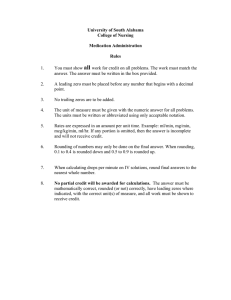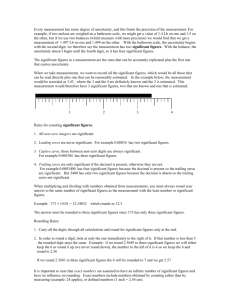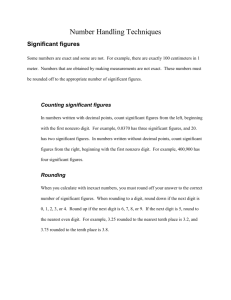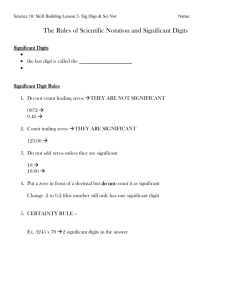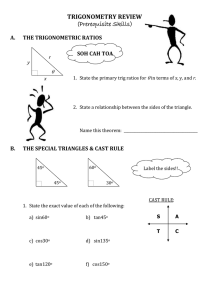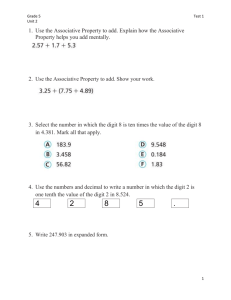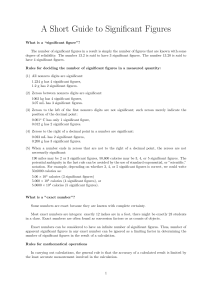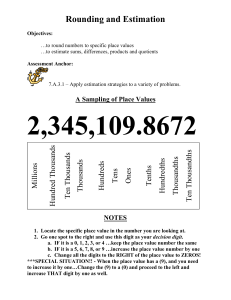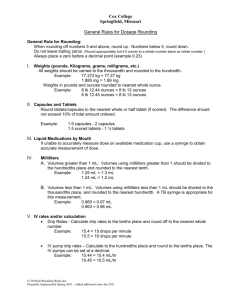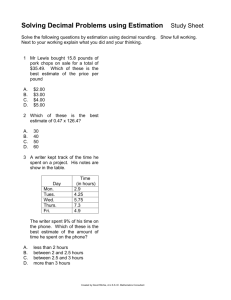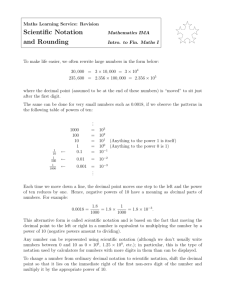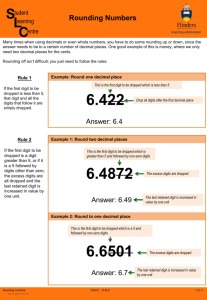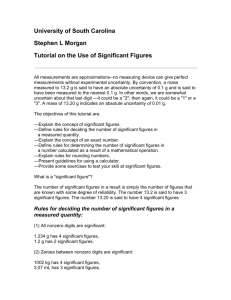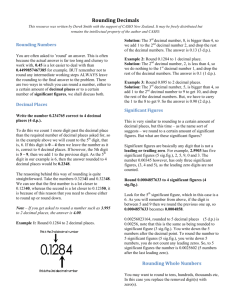SIGNIFICANT FIGURES IN MEASUREMENTS AND COMPUTATIONS
advertisement
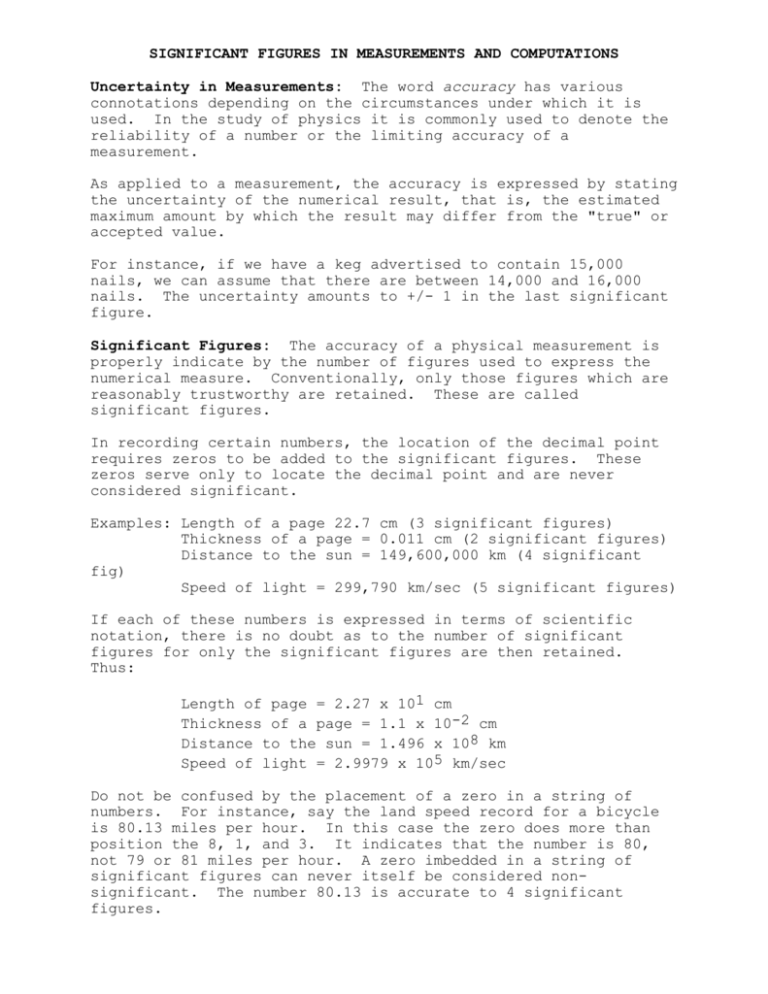
SIGNIFICANT FIGURES IN MEASUREMENTS AND COMPUTATIONS Uncertainty in Measurements: The word accuracy has various connotations depending on the circumstances under which it is used. In the study of physics it is commonly used to denote the reliability of a number or the limiting accuracy of a measurement. As applied to a measurement, the accuracy is expressed by stating the uncertainty of the numerical result, that is, the estimated maximum amount by which the result may differ from the "true" or accepted value. For instance, if we have a keg advertised to contain 15,000 nails, we can assume that there are between 14,000 and 16,000 nails. The uncertainty amounts to +/- 1 in the last significant figure. Significant Figures: The accuracy of a physical measurement is properly indicate by the number of figures used to express the numerical measure. Conventionally, only those figures which are reasonably trustworthy are retained. These are called significant figures. In recording certain numbers, the location of the decimal point requires zeros to be added to the significant figures. These zeros serve only to locate the decimal point and are never considered significant. Examples: Length of a page 22.7 cm (3 significant figures) Thickness of a page = 0.011 cm (2 significant figures) Distance to the sun = 149,600,000 km (4 significant fig) Speed of light = 299,790 km/sec (5 significant figures) If each of these numbers is expressed in terms of scientific notation, there is no doubt as to the number of significant figures for only the significant figures are then retained. Thus: Length of page = 2.27 x 101 cm Thickness of a page = 1.1 x 10-2 cm Distance to the sun = 1.496 x 108 km Speed of light = 2.9979 x 105 km/sec Do not be confused by the placement of a zero in a string of numbers. For instance, say the land speed record for a bicycle is 80.13 miles per hour. In this case the zero does more than position the 8, 1, and 3. It indicates that the number is 80, not 79 or 81 miles per hour. A zero imbedded in a string of significant figures can never itself be considered nonsignificant. The number 80.13 is accurate to 4 significant figures. Further, do not be confused by a zero which is said to be of significance. Something may be measured to an accuracy of 2.000 units. In this case we know that the measurement is accurate to three decimal places. That is, the measurement lay somewhere between 2.001 and 1.999. There are some numbers which, by their definition, may be taken to have an unlimited number of significant figures. For example, the integer 2 and the irrational number π in the following relationship for a circle: circumference = 2π(radius). In calculations there is frequent need to use data that have been recorded without a clear indication of the number of significant figures. For example, a textbook problem may refer to a "twokilogram mass", or in an experiment a student may announce that she has measured a certain distance as "3 meters". In such cases the values with the approximate number of significant figures should be written from what is know or assumed about the way in which the measurement were made. If the distance referred to were measured with an ordinary tape measure, the distance might appropriately be written as 3.0 meters. If the distance were carefully measured with a steel scale accurate to the nearest millimeter, the distance might be recorded as 3.000 meters. In academic problem work a good rule to follow is to retain three figures unless there is good reason to decide otherwise. Rules for Computation: There is always a pronounced and persistent tendency on the part of beginners to retain too many figures in a computation. This not only involves too much work but, worse still, leads to a fictitiously precise result. The following rules are recommended and will save much time that would otherwise be spent in calculation. Furthermore, their careful use will result in properly indicated accuracies. 1. In recording the result of a measurement or calculation, one, and only one, doubtful digit is retained. For instance, a caliper whose finest division is 100-thousandths can produce a measurement that is accurate to five decimal places at best. i.e. 3.02364. 2. In addition or subtraction, do not carry the result beyond the first column that contains a doubtful figure. Add all figures and then round (see #4 below) the result. For example: 23.6543 10.01__ 33.6643 which becomes 33.66 3.4 -2.554 0.846 which becomes 0.8 3. In multiplication and division, carry the result to the same number of significant figures that there are in that term which has the least number of significant figures. For example: 3.95 x 5.1 = 20.145, rounded to 2 significant figures = 20. 34.2/6.29934 = 5.429140196... becomes upon rounding 5.43 4. In dropping figures that are not significant (rounding), the last figure retained should be unchanged if the following figures dropped are less than half the previous digit. It should be increased by 1 if the following figures dropped are greater than half the previous digit. If the following figures dropped is precisely half, the preceding digit should be unchanged if it is an even number but increased by 1 if it is an odd number. For example: 24.5627 rounded to four significant figures becomes 24.56 34.2523 rounded to three significant figures becomes 34.3 3.485 rounded to three significant figures becomes 3.48 7.550 rounded to two significant figures becomes 7.6
